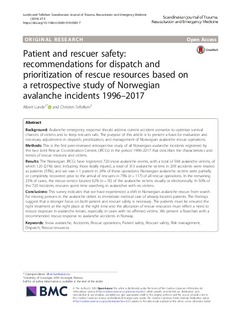| dc.contributor.author | Lunde, Albert | |
| dc.contributor.author | Tellefsen, Christen | |
| dc.date.accessioned | 2019-08-22T07:57:02Z | |
| dc.date.available | 2019-08-22T07:57:02Z | |
| dc.date.created | 2019-03-08T12:05:19Z | |
| dc.date.issued | 2019-01 | |
| dc.identifier.citation | Scandinavian Journal of Trauma, Resuscitation and Emergency Medicine. 2019, 27 (5), 1-8. | nb_NO |
| dc.identifier.issn | 1757-7241 | |
| dc.identifier.uri | http://hdl.handle.net/11250/2609748 | |
| dc.description.abstract | Background: Avalanche emergency response should address current accident scenarios to optimize survival chances of victims and to keep rescuers safe. The purpose of this article is to present a basis for evaluation and necessary adjustments in dispatch, prioritization, and management of Norwegian avalanche rescue operations. Methods: This is the first peer-reviewed retrospective study of all Norwegian avalanche incidents registered by the two Joint Rescue Co-ordination Centers (JRCCs) in the period 1996–2017 that describes the characteristics and trends of rescue missions and victims. Results: The Norwegian JRCCs have registered 720 snow avalanche events, with a total of 568 avalanche victims, of which 120 (21%) died. Including those fatally injured, a total of 313 avalanche victims in 209 accidents were treated as patients (55%), and we saw >1 patient in 24% of these operations. Norwegian avalanche victims were partially or completely recovered prior to the arrival of rescuers in 75% (n=117) of all rescue operations. In the remaining 25% of cases, the rescue service located 62% (n=55) of the avalanche victims visually or electronically. In 50% of the 720 incidents, rescuers spent time searching in avalanches with no victims. Conclusions: This survey indicates that we have experienced a shift in Norwegian avalanche rescue: from search for missing persons in the avalanche debris to immediate medical care of already-located patients. The findings suggest that a stronger focus on both patient and rescuer safety is necessary. The patients must be ensured the right treatment at the right place at the right time and the allocation of rescue resources must reflect a need to reduce exposure in avalanche terrain, especially in cases with no affirmed victims. We present a flowchart with a recommended rescue response to avalanche accidents in Norway. | nb_NO |
| dc.language.iso | eng | nb_NO |
| dc.publisher | BioMed Central | nb_NO |
| dc.rights | Navngivelse 4.0 Internasjonal | * |
| dc.rights.uri | http://creativecommons.org/licenses/by/4.0/deed.no | * |
| dc.subject | akuttmedisin | nb_NO |
| dc.subject | pasientsikkerhet | nb_NO |
| dc.subject | redningsoperasjoner | nb_NO |
| dc.subject | snøskred | nb_NO |
| dc.subject | ulykker | nb_NO |
| dc.subject | risikostyring | nb_NO |
| dc.title | Patient and rescuer safety: recommendations for dispatch and prioritization of rescue resources based on a retrospective study of Norwegian avalanche incidents 1996–2017 | nb_NO |
| dc.type | Journal article | nb_NO |
| dc.type | Peer reviewed | nb_NO |
| dc.description.version | publishedVersion | nb_NO |
| dc.rights.holder | © The Author(s). | nb_NO |
| dc.subject.nsi | VDP::Medical disciplines: 700 | nb_NO |
| dc.source.pagenumber | 1-8 | nb_NO |
| dc.source.volume | 27 | nb_NO |
| dc.source.journal | Scandinavian Journal of Trauma, Resuscitation and Emergency Medicine | nb_NO |
| dc.source.issue | 5 | nb_NO |
| dc.identifier.doi | 10.1186/s13049-019-0585-7 | |
| dc.identifier.cristin | 1683250 | |
| cristin.unitcode | 217,8,3,0 | |
| cristin.unitname | Institutt for sikkerhet, økonomi og planlegging | |
| cristin.ispublished | true | |
| cristin.qualitycode | 1 | |

